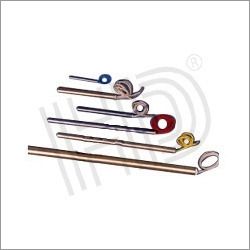We are offering Rod Heaters for a range of commercial applications. This is renowned for its effectiveness at high temperatures. The heater is made of high-grade stainless steel, which prevents corrosion. It is ideal for applications with high vibration because it evenly disperses heat. This heater’s sturdy construction ensures that it can support heavy loads and provide top-notch performance. Every step of the production process for our Rod Heater is examined to make sure the product is error-free.
Various industries and common household appliances use rod heaters, also known as heating rods or heating elements, for heating applications. These heaters are made of an element that is cylindrical or rod-shaped and produces heat when an electric current flows through it.
Typically, high electrical resistance materials like nichrome (a nickel-chromium alloy) or Kanthal (an iron-chromium-aluminum alloy) are used to create rod heaters. These alloys can survive the high temperatures needed for heating applications because they have a high melting point.
A rod heater’s design can change based on what it will be used for. To enhance their surface area and maximise heat production, rod heaters are frequently coiled in home appliances like electric stoves and ovens. The coiled shape enables efficient heating and equal heat dispersion.
Rod heaters are employed in a variety of industrial contexts, including heat treatment procedures, industrial ovens, and manufacturing operations that call for precise and regulated heating. These heaters can be specifically created to meet needs in terms of size, power, and operating temperature.
Rod heaters can be controlled with thermostats or temperature controllers to maintain the correct temperature. They are normally wired to a power source. To avoid overheating and potential risks, safety measures like thermal fuses and temperature limiters are frequently used.
Rod heaters are effective and frequently used, but it’s vital to remember that because of the high temperatures they can reach, they should be handled carefully. To ensure safe and efficient functioning, proper installation, maintenance, and adherence to safety regulations are necessary.


